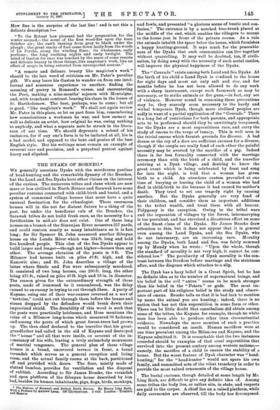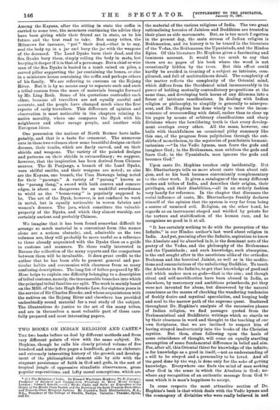THE DYAKS OF BORNEO.*
WE generally associate Dyaks with the murderous pastime of head-hunting and the remarkable dynasty of the Brookes, but the Land and Sea Dyaks have other claims on the interest of the curious. The numerous tribes and clans which are now more or less civilised in North Borneo and Sarawak have some peculiar customs connected with child-birth and burial, and a system of communal village houses that must have a quite unusual fascination for the ethnologist. These enormous houses will in the not far distant future be a thing of the past, for under the beneficent rule of the Brookes, the Sarawak tribes do not build fresh ones, as the necessity for a fortification in mid-air does not exist. One of these long houses on a branch of the Simunjan River measures 257 yards, and could contain nearly as many inhabitants as it is feet long ; for Sir Spencer St. John measured another Sibuyau house on the Lundu River which was 534 ft. long and held five hundred people. This clan of the Sea Dyaks appear to build larger and longer—though not higher—houses than any other. The average elevation of the posts is 8 ft. The Milanow had houses built on piles 40 ft. high, and the Kanowit also ; and St. John describes a village of the litter where Steele and Fox were subsequently murdered. It consisted of two long houses, one 200 ft. long, the other being 475 ft., raised on piles 40 ft. high and 18 in. in diameter. The reason given for the extraordinary strength of these posts, made of ironwood be it remembered, was the delay caused to an enemy in trying to cut through them. A party of Kayans, using one of their war-canoes reversed as a sort of "tortoise," could not cut through them before the beams and stones dropped by the defenders would break down their improvised shield. The durability of this wood is such that the posts were practically heirlooms, and Hose mentions the ruins of a Milanow long-house which measured 96 fathoms, and among the posts of which great forest-trees had grown up. The then chief declared to the traveller that his great- grandfather had called in the aid of Kayans and destroyed the " house " and all that were inside, on account of the in- constancy of his wife, leaving a truly melancholy monument of marital vengeance. The general plan of these village houses is a broad, uncovered terrace in front, a broad verandah which serves as a general reception and living room, and the actual family rooms at the back, partitioned off and provided with doors. The floor, mostly made of slatted bamboo, provides for ventilation and the disposal of rubbish. According to Sir James Brooke, the verandah and open platform of the Sibnyau house described by him had, besides its human inhabitants, pigs, dogs, birds, monkeys, • The Natives of Sarawak and British North Borns*. By Henry Ling Roth. With a Preface by Andrew Lang. 550 Illustrations. 2 vols. London: Truelove and Haason
and fowls, and presented "a glorious scene of bustle and con- fusion." The entrance is by a notched tree-trunk placed at the middle of the end, which enables the villagers to mount to the house just in front of the private rooms. As a rule the animals inhabit the apace below the house, which furnishes a happy hunting-ground. It says much for the peaceable- ness of the Dyaks that such communities can live together without quarrelling. It may well be doubted, too, if civili- sation, by doing away with the necessity of such aerial castles, will improve the physical happiness of the Dyaks.
The" Of:Invade " exists among both Land and Sea Dyaks. At the birth of his child a Land Dyak is confined to the house for eight days and must eat only salt and rice, and for months before he has not been allowed to do any work with a sharp instrument, except such farmwork as may be necessary, or to strike animals or fire guns,—in fact, any act of violence. However sound in reasoning these precautions may be, they scarcely seem necessary to the hardy and withal temperate Dyak, though more civilised peoples are sadly in want of a partial application of the " Couvade." There is a long list of restrictions for both parents, and appropriate acts to be performed should they be unwittingly trespassed, for the Dyaks are a most superstitious race, and carry the study of omens to the verge of lunacy. This is well seen in the trivial omens which furnish grounds for divorce. A bad dream or the cry of a deer are sufficient excuses for a divorce, though if the couple are really fond of each other the painful necessity may be averted by the sacrifice of a pig. Indeed there is far less formality connected with the marriage ceremony than with the birth of a child, and the traveller arriving at a Dyak village, and desiring to know the great event which is being celebrated by feast and song far into the night, is told that a woman has given birth to a child. An atrocious custom prevailed at one time of burying or leaving the child of a woman who had died in child-birth to die because it had caused its mother's death. They tried to set one tragedy right by causing another. But the Dyaks generally are very fond of their children, and consider them as important additions to the tribal wealth, and treat them with all honour. Polygamy is the exception. Owing to the tribal wars and the separation of villages by the forest, intermarrying is too prevalent, and has exercised a disastrous effect on some of the finest clans of the Dyaks. Sir James Brooke drew attention to this, but it does not appear that it is general even among the Land Dyaks, and the Sea Dyaks, who do not intermarry, are an increasing race. Morality among the Dyaks, both Land and Sea, was fairly summed up by Mundy when he wrote : "Upon the whole, though the standard of morality is not very high, it cannot be con- sidered low." The peculiarity of Dyak morality is the con- trast between the freedom before marriage and the strictness after, and the disgrace which attaches to a slip.
The Dyak has a hazy belief in a Great Spirit, but he has no definite idea as to the number of supernatural beings, and his belief in the evil " antus " seems to be much stronger than his belief in the " Petara " or gods. The most im- portant part of his religious belief is the study and observ- ance of omens. Brooke tells us that it is bad luck to mention by name the animal you are hunting ; indeed, there is no nation that has not this superstition in some form or other. There can be little doubt that cannibalism did obtain among some of the tribes, the Kayans for example, though no white man has been able to produce other than circumstantial evidence. Nowadays the mere mention of such a practice would be considered an insult. Human sacrifices were at one time prevalent among the Milanows and Kayans, and the Kayans admitted it. It is remarkable that the two instances recorded should be examples of that cruel superstition that survived into the present century among western nations,— namely, the sacrifice of a child to ensure the stability of a house. But the worst feature of Dyak character was "head- hunting," for the " head-hunter " would not spare his own family, and committed acts of the vilest treachery in order to provide the most valued ornaments of the village house.
The burial customs, though detailed at some length by Mr. Ling Roth, are difficult to give any definite idea of. Among some tribes the body lies, or rather sits, in state, and respects are paid to the corpse. A chief lies on a raised platform, while daily ceremonies are observed, till the body has decomposed.
Among the Kayans, after the sitting in state the coffin is carried to some tree, the mourners continuing the advice they have been giving while their friend sat in state, as to his future and the beat road to take. But many tribes, the Milanows for instance, " pot " their dead,—that is to say, seal the body up in a jar and bury the jar with the weapons of the deceased. The Land Dyaks burn their dead, and the Sea Dyaks bury them, simply rolling the body in mats, but burying it deeper if it is that of a personage. But a chief or wise man of the Sea Dyaks is buried in a tomb raised on piles, a carved pillar supporting the jar containing the bones, or else in a miniature house containing the coffin and perhaps others of his family. We are referring to customs on the Rejang River. But it is by no means easy to separate such and such a tribal custom from the mass of materials brought forward by Mr. Ling Roth. Some of his quotations contradict each other, because all travellers are not equally careful and accurate, and the people have changed much since the first reports of early travellers. This difference of opinion and observation is most noticeable in the chapters relating to native morality, where one compares the Dyak with his neighbours and other savage people, and another with European ideas.
One possession the nations of North Borneo have indis- putably, and that is a taste for ornament. The numerous cuts in these two volumes show some beautiful designs on their dresses, their tombs, which are finely carved, and on their shields and weapons. The variety of the painted designs and patterns on their shields is extraordinary ; we suppose, however, that the inspiration has been derived from Chinese sources. The Si Panjangs, a branch of the Land Dyaks, were skilful smiths, and their weapons are noted ; so also are the Kayans, one branch, the Uma Bawangs being noted for their " parangs." A variety of " parang" known as the " parang hang," a sword with botb convex and concave edges, is about as dangerous for an unskilful swordsman to wield as the "boomerang" is popularly supposed to be. The art of the Dyak, however, is not confined to work in metal, but is equally noticeable in woven fabrics and women's dresses. The jars, which constitute the valuable property of the Dyaks, and which they almost worship, are certainly ancient and probably Chinese.
We imagine that it has been found somewhat difficult to arrange so much material in a convenient form (the names alone are a serious obstacle), and, admirable as the two volumes are, they will probably be more useful as a reference to those already acquainted with the Dyaks than as a guide to customs and manners. To those really interested in Borneo the collection of the many reports and the comparison between them will be invaluable. It does great credit to the author that he has been able to present general and par- ticular habits and ceremonies with clearness from so many confusing descriptions. The long list of tribes prepared by Mr. Hose helps to explain one difficulty belonging to a description of tribal customs, namely, the innumerable branches into which the principal tribal families are split. The work is mainly based on the MSS. of the late Hugh Brooke Low, for eighteen years in the service of Sir Charles Brooke, and whose acquaintance with the natives on the Rejang River and elsewhere has provided undoubtedly sound material for a real study of the subject. The illustrations do justice to the art of the many tribes, and are in themselves a most valuable part of these care- fully prepared and most interesting papers.



















































 Previous page
Previous page